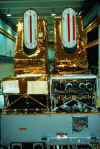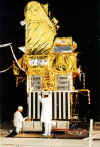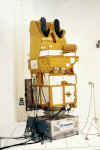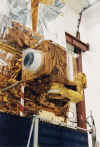Tests
 The satellite equipment and
subsystems undergo functional and environmental tests before being integrated with the
satellite. During assembly, the mechanical and electrical interfaces with the satellite
are checked, then the first functional and performance tests are carried out.
The satellite equipment and
subsystems undergo functional and environmental tests before being integrated with the
satellite. During assembly, the mechanical and electrical interfaces with the satellite
are checked, then the first functional and performance tests are carried out.
 The
integration and test procedures for satellite and subsystem equipment are first validated
on the satellite "engineering model (EM) ". This is done to "ensure
equipment safety" during all operations and tests so that they can be safely carried
out on the flight model.
The
integration and test procedures for satellite and subsystem equipment are first validated
on the satellite "engineering model (EM) ". This is done to "ensure
equipment safety" during all operations and tests so that they can be safely carried
out on the flight model.
Performance tests are carried out before and after the environmental tests. These are
done ensure that environmental test undergone by the satellite and subsystem have not
degraded performances at either equipment or sub-equipment level.
These check quickly that the satellite is operating as it should. They are carried out
each time the bus and payload are mated or between environmental test sequences.
This operation involves mating and unmating of the two main satellite modules, the bus
and the payload. During this operation the electrical connections between the two modules
are thoroughly checked.
This involves checking at the satellite level, that the equipment and subsystems
operate correctly and efficiently when used simultaneously.
Electromagnetic "interference" generated by equipment or subsystems can be
propagated by power lines or be radiated outwards. This test measures interference levels
and checks whether the equipment and subsystems operate nominally and efficiently when
they are subjected to slightly higher levels of interference.
 Some equipment and subsystems
include RF transmitters for satellite/ground links. This test checks that equipment and
subsystems are operating nominally and efficiently when their transmitters are active.
Some equipment and subsystems
include RF transmitters for satellite/ground links. This test checks that equipment and
subsystems are operating nominally and efficiently when their transmitters are active. 

 The
attitude control system consists of navigation sensors (gyroscopes, Earth and Sun sensors)
and actuators (thrusters, reaction wheels, magnetic torquers). The sign tests check
actuators operation in response to changing sensor input signals (by analysing consistency
in the direction of attitude adjustments made by the actuators).
The
attitude control system consists of navigation sensors (gyroscopes, Earth and Sun sensors)
and actuators (thrusters, reaction wheels, magnetic torquers). The sign tests check
actuators operation in response to changing sensor input signals (by analysing consistency
in the direction of attitude adjustments made by the actuators).
The satellite tanks used to supply the attitude control system have to be filled in
order to resist mechanical stresses. Before carrying out the vibration tests, the two
tanks are filled with a water/alcohol mixture which is less dangerous than the hydrazine
used during the flight. After the test, the tanks are drained and flushed clean with an
inert gas.
The attitude control system consists of two tanks and valves and tubes. These are
checked for leak tightness before and after the environmental tests to detect the
slightest leak which might prove fatal.
 During
these tests the orbital environment is simulated, including pressure, temperature and
solar radiation. The bus and payload are tested separately; the test ensure that they are
operating correctly and also check their thermal control equipment.
During
these tests the orbital environment is simulated, including pressure, temperature and
solar radiation. The bus and payload are tested separately; the test ensure that they are
operating correctly and also check their thermal control equipment.
This environmental test simulates conditions of extreme temperature and pressure. The
test subject is the complete satellite flight model. This test checks that the satellite
and its thermal control system are operating correctly.
The solar array converts solar radiation into electrical power. It is integrated with
the satellite for the integration tests. Since it is fragile, it is integrated with the
satellite before the vibration tests and removed afterwards. It is definitively installed
during the launch campaign.
 During
this test, the mockup satellite structure (used to prepare the test) and the flight model
are vibration tested along all three axes to observe the response of structure, equipment
and subystems.
During
this test, the mockup satellite structure (used to prepare the test) and the flight model
are vibration tested along all three axes to observe the response of structure, equipment
and subystems.
Acoustic vibration test
 This
test simulates the noise generated by the launcher during launch and checks whether the
satellite can withstand the enormous stress.
This
test simulates the noise generated by the launcher during launch and checks whether the
satellite can withstand the enormous stress.
Alignments are checked before and after the environmental tests. The resulting
measurement data are used to check that the satellite structure, equipment and subsystems
have not changed shape as a result of test loads. Alignments are checked again before
beginning the campaign to establish attitude control and reference marks for the various
instruments, to increase the attitude control efficiency during satellite operations.
This test checks that the pyrotechnic systems used to release mechanisms after the
launch, are operating correctly. Electrical pulses are sent to activate pyrotechnic
charges which in turn release devices by breaking their securing cables or bolts
(shearing).
The satellite's onboard software includes: central flight software and decentralised
software. The central flight software which is linked to the ground segment commands and
monitors the satellite. The decentralised software programs manage various items of
equipment and subsystems (Vegetation, Pastel, Pastec, etc.). These programs communicate
between themselves and with the ground segment. The tests check for correct operation
under nominal conditions or in the event of anomalies, and in particular to ensure that
information flows as it should.
During these tests, all system components are in place. The satellite is controlled by
ground control exactly as it would be in orbit. The tests are peformed to validate the
SPOT system completed with the SPOT 4 satellite for the main operational phases:
launch, orbit acquisition, operational mission and anomaly investigation and processing.
In addition, the operational qualification test checks operator skill in applying
operational procedures and using resources previously validated during the technical
qualification tests.
top of page, article

page updated on the 00-06-06
 The satellite equipment and
subsystems undergo functional and environmental tests before being integrated with the
satellite. During assembly, the mechanical and electrical interfaces with the satellite
are checked, then the first functional and performance tests are carried out.
The satellite equipment and
subsystems undergo functional and environmental tests before being integrated with the
satellite. During assembly, the mechanical and electrical interfaces with the satellite
are checked, then the first functional and performance tests are carried out.






